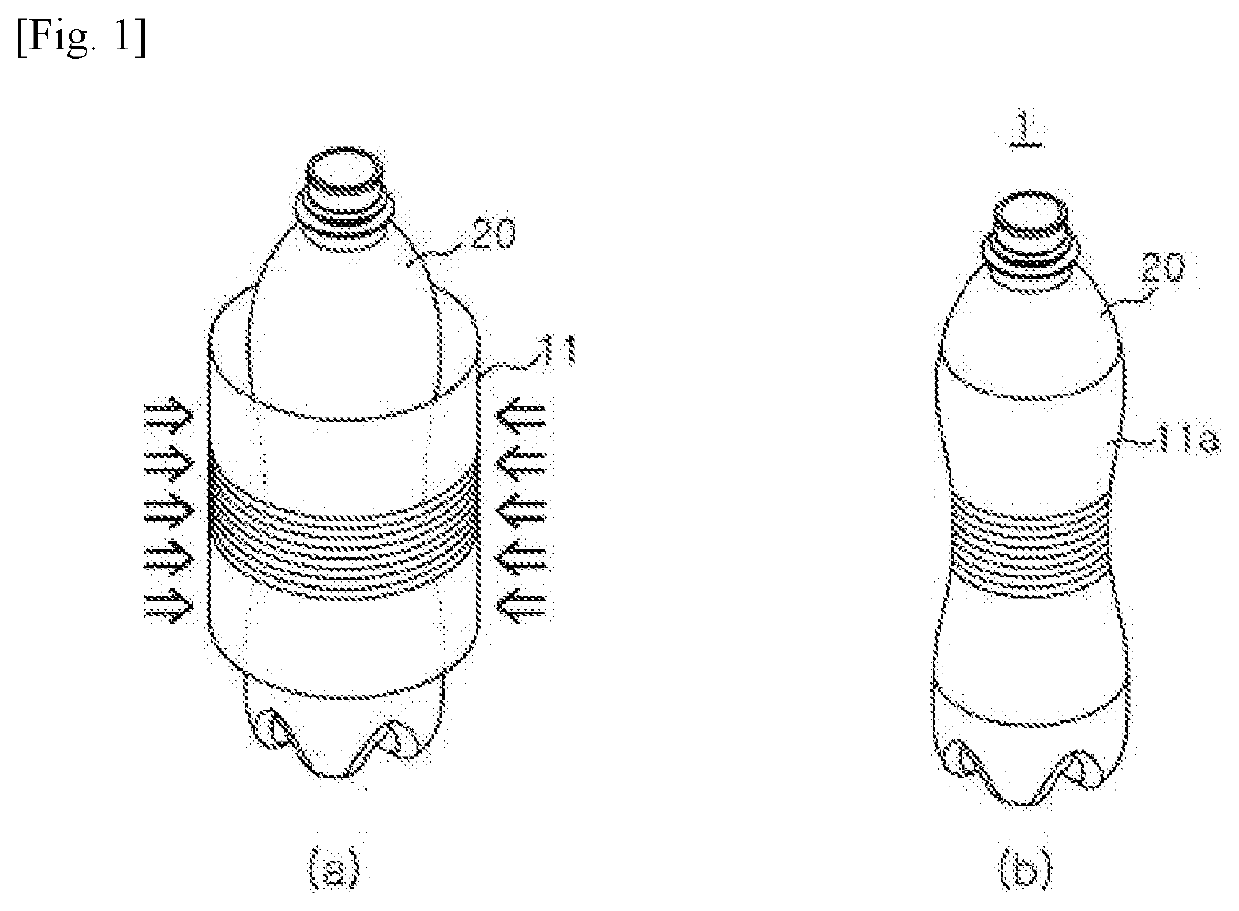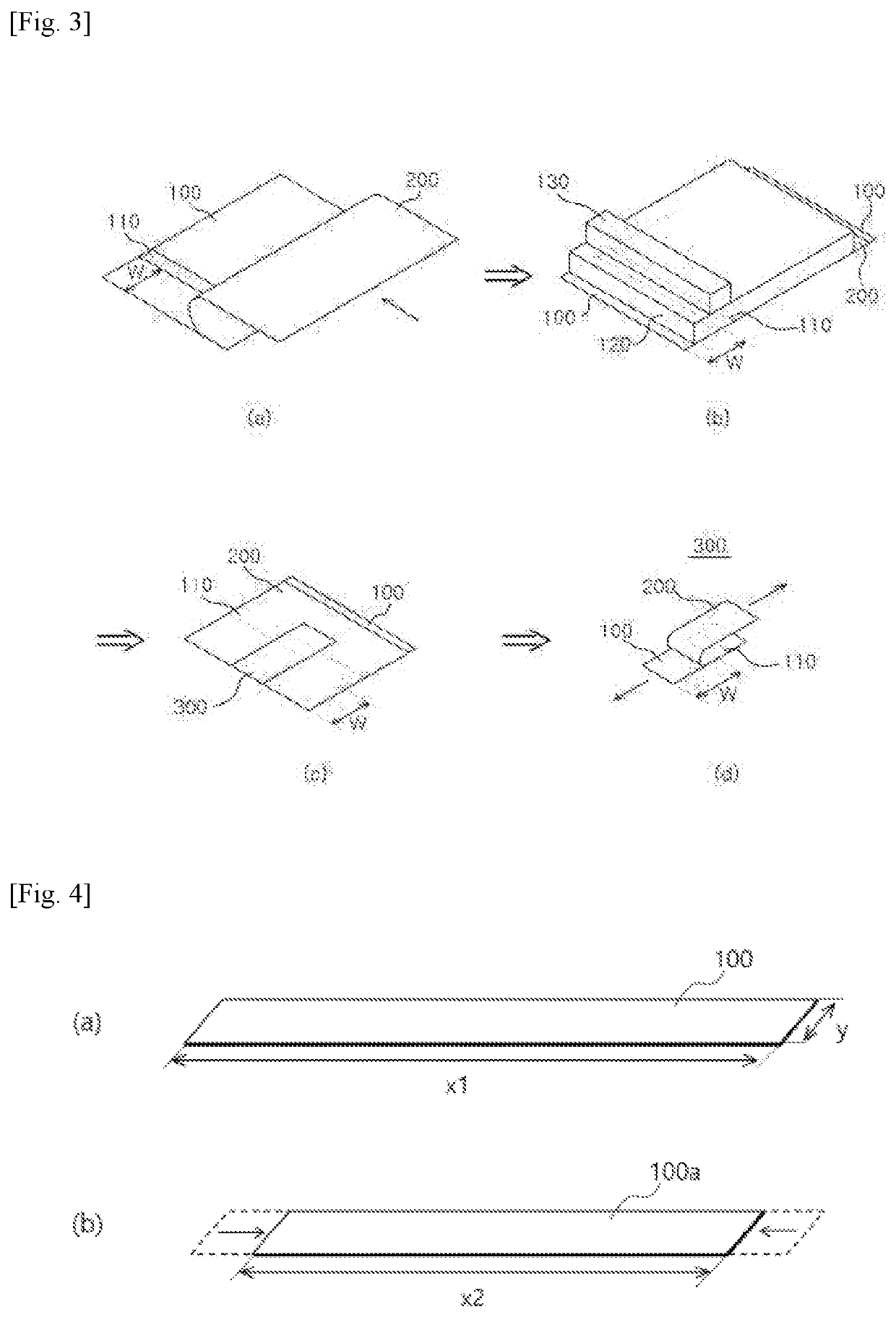Polyester film, preparation method thereof and method for reproducing polyethyleneterephthalate container using same
a polyethyleneterephthalate and polyethylene terephthalate technology, applied in the field of polyethylene terephthalate, can solve the problems of non-uniform shrinkage or distortion of plastic containers, and achieve the effects of improving thermal properties and chemical characteristics, easy control of crystallinity, and excellent shrinkage ra
- Summary
- Abstract
- Description
- Claims
- Application Information
AI Technical Summary
Benefits of technology
Problems solved by technology
Method used
Image
Examples
example 1-1
[0170](1) Preparation of a Copolymerized Polyester Resin
[0171]An autoclave (or first reactor) equipped with a stirrer and a distillation column was charged with 100% by mole of terephthalic acid (TPA) as a dicarboxylic acid and 75.6% by mole of ethylene glycol (EG), 18.8% by mole of neopentyl glycol (NPG), and 5.6% by mole of diethylene glycol (DEG) as a diol. 0.07 part by weight of manganese acetate as a transesterification catalyst was added per 100 parts by weight of the dicarboxylic acid, followed by heating the mixture to 220° C. and the removal of methanol produced as a byproduct to carry out the reaction.
[0172]Upon completion of the transesterification reaction, 0.07 part by weight of silica having an average particle diameter of 0.28 μm was added per 100 parts by weight of the dicarboxylic acid, and 0.4 part by weight of trimethyl phosphate as a stabilizer was added. After 5 minutes, 0.035 part by weight of antimony trioxide and 0.005 part by weight of tetrabutylene titanate...
examples 1-2 to 1-9
and Comparative Examples 1-1 to 1-9
[0176]Polyester films were prepared in the same manner as in Example 1-1, except that the contents of the dicarboxylic acid and the diol, the content of the homopolyethylene terephthalate, and the process conditions were changed as shown in Table 1 below.
[0177]The final components of the polyester films prepared in Examples 1-1 to 1-9 and Comparative Examples 1-1 to 1-9 are shown in Table 2 below.
TABLE 1HOMO-PETStretchingPreheatingHeat-setting(part byratiotemp.temp.weight)TDMD(° C.)(° C.)Ex. 1-1104.15—10575Ex. 1-234.15—10585Ex. 1-354.15—10590Ex. 1-454.15—10575Ex. 1-5104.15—10575Ex. 1-6204.15—10575Ex. 1-7204.5—11570Ex. 1-8104.15—10593Ex. 1-9304.15—10575C. Ex. 1-1—4.5—11570C. Ex. 1-2—4.5—11575C. Ex. 1-3—4.5—11585C. Ex. 1-4—4.5—11590C. Ex. 1-5404.15—10577C. Ex. 1-6604.15—10570C. Ex. 1-7804.15—10575C. Ex. 1-8—4.5—11575C. Ex. 1-9—4.5—11575
TABLE 2TPAEGNPGCHDMDEG(% by(% by(% by(% by(% bymole)mole)mole)mole)mole)Ex. 1-110078.017.0—5.0Ex. 1-210078.017.0—5.0...
example 2-1
[0195](1) Preparation of a Polyethylene Terephthalate Container Provided with a Polyester Film
[0196]FIG. 1 shows a polyester film applied to a product before and after heat shrinkage thereof. Referring to FIG. 1, a part of the outer surface of a polyethylene terephthalate container (PET container, 30 g) was wrapped with the polyester film prepared in Example 1-1 (see FIG. 1(a)). In such event, it was fixed using an acrylic adhesive. Thereafter, the polyester film of Example 1-1 was shrunk at a temperature of 90° C. under a hot air condition to obtain a polyethylene terephthalate container provided with a polyester film (see FIG. 1(b)).
[0197](2) Regeneration Process of a Polyethylene Terephthalate Container
[0198]The container provided with a polyester film prepared in step (1) was crushed with a crusher to obtain flakes. The flakes were first washed with water. Thereafter, the flakes were second washed for 15 minutes with a washing solution (a mixture of a solution of 0.3% by weight ...
PUM
| Property | Measurement | Unit |
|---|---|---|
| peel strength | aaaaa | aaaaa |
| Tm | aaaaa | aaaaa |
| temperature | aaaaa | aaaaa |
Abstract
Description
Claims
Application Information
 Login to View More
Login to View More - R&D
- Intellectual Property
- Life Sciences
- Materials
- Tech Scout
- Unparalleled Data Quality
- Higher Quality Content
- 60% Fewer Hallucinations
Browse by: Latest US Patents, China's latest patents, Technical Efficacy Thesaurus, Application Domain, Technology Topic, Popular Technical Reports.
© 2025 PatSnap. All rights reserved.Legal|Privacy policy|Modern Slavery Act Transparency Statement|Sitemap|About US| Contact US: help@patsnap.com



